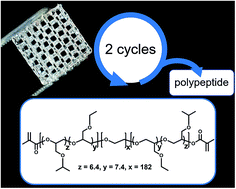Poly(alkyl glycidyl ether) hydrogels for harnessing the bioactivity of engineered microbes†
Abstract
Herein, we describe a method to produce yeast-laden hydrogel inks for the direct-write 3D printing of cuboidal lattices for immobilized whole-cell catalysis. A poly(alkyl glycidyl ether)-based triblock copolymer was designed to have three important features for this application: (1) a temperature response, which allowed for facile processing of the material; (2) a shear response, which facilitated the extrusion of the material through a nozzle; and (3) UV light induced polymerization, which enabled the post-extrusion chemical crosslinking of network chains, and the fabrication of robust printed objects. These three key stimuli responses were confirmed via rheometrical characterization. A genetically-engineered yeast strain with an upregulated α-factor production pathway was incorporated into the hydrogel ink and 3D printed. The immobilized yeast cells exhibited adequate viability of 87.5% within the hydrogel. The production of the upregulated α-factor was detected using a detecting yeast strain and quantified at 268 nM (s = 34.6 nM) over 72 h. The reusability of these bioreactors was demonstrated via immersion of the yeast-laden hydrogel lattice in fresh SC media and confirmed by the detection of similar amounts of upregulated α-factor at 259 nM (s = 45.1 nM). These yeast-laden materials represent an attractive opportunity for whole-cell catalysis of other high-value products in a sustainable and continuous manner.

- This article is part of the themed collection: Nanolithography of biointerfaces


 Please wait while we load your content...
Please wait while we load your content...